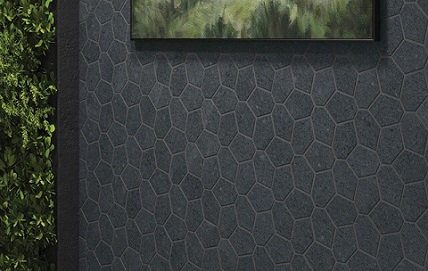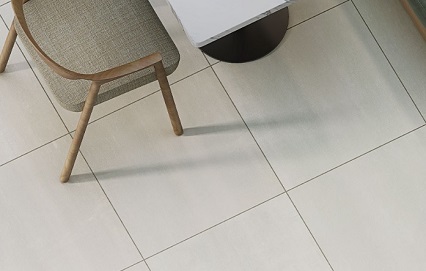
CROSSVILLE, TENN.—Just days ago, the National Oceanic and Atmospheric Administration (NOAA) announced that carbon dioxide (CO2) levels at the Mauna Loa Atmospheric Baseline Observatory peaked at 424 parts per million in May, continuing a steady climb further into territory not seen for millions of years. (In 1960, levels were below 320 parts per million.) Such high levels of CO2 impact our planet negatively in many ways.
Recognizing this impact, stakeholders throughout the lodging industry are taking steps to reduce their own contributions to CO2 levels. One such company is Crossville, Inc., a leading provider of porcelain stone, glass, and natural stone tile for both residential and commercial settings in interior and exterior floors, walls, and countertops.
In April, Crossville announced aggressive carbon reduction goals affecting its tiles’ global warming potential with a goal of achieving a 30 percent reduction in manufacturing embodied carbon by 2030. Also in April, Crossville announced two new manufactured collections that will be carbon neutral through measuring embodied carbon (EPD) and purchasing carbon offsets to account for what cannot be immediately reduced for the full lifecycle of these product lines. The Civilization Collection and the Native Metal Collection are the company’s first carbon-neutral products.
Green Lodging News recently interviewed Lindsey Waldrep, Crossville’s VP of Marketing, and Noah Chitty, Crossville’s Director of Technical Services, to learn about Crossville’s recently announced initiatives and other steps it is taking to reduce its carbon impact. The following is the result of that interview in a Q&A format.
Why did Crossville believe it was important to have product lines available that are carbon neutral? How much of that was driven internally and how much by customer request/pressure?
Actually, it was the carbon reduction plan that we think is the most important, but there are initiatives at AIA and with interior designers seeking to find low-carbon or no-carbon products, so until we complete carbon elimination, carbon neutral products are what we can provide to fulfill those requests. At this point, only some of our large national accounts and larger A&D firms have expressed interest, but we anticipate that those requests will grow quickly in the very near future.
What must your company do internally still to get to the point where carbon offsets are no longer needed?
The main driver in the product stage is natural gas and electricity, unless something major changes, then we will need an alternative to natural gas. Until then, there are many things we can work on. We believe we can affect in some way most of the other impacts that come from the rest of the building lifecycle.
How does Crossville intend to achieve an additional 10 percent reduction in its tiles’ global warming potential by 2024 and a 30 percent reduction from its 2014 baseline by 2030? Can you give me an example of a change in a manufacturing process that has resulted in energy reduction? Can you give me an example of how a change in product—perhaps the material in that product—has led to energy reduction?
Optimizing kiln times, replacing less efficient motors, looking for ways to use energy created by one process for a different process, are all examples of process changes. Making sure we find the right balance between the necessary high quality performance characteristics and product thickness as well as maximizing recycled content are all product modifications that could lead to reduced energy consumption.
Define “cradle to grave” carbon credits.
“Cradle to grave” (as opposed to “cradle to gate”) means we are purchasing credits to offset the entire product lifecycle as defined by the Environmental Product Declaration (EPD). By considering the carbon footprint of our tiles from inception through demolition and destruction, our “cradle to grave” carbon credits do more for the environment.
Can you give me an example of a supply chain improvement that has led to less energy consumption/less carbon? Perhaps an initiative a supplier has taken.
We are looking at ways our raw material suppliers can support this initiative. For some raw materials (and even our electricity), our initiatives have resulted in greater understanding of our specific supply chain partners that may be better than some of the national average assumptions that go into creating the Life Cycle Analysis (LCA) and EPD. For example, our electricity company is doing better from a green energy perspective than the national average that was used when we did our last EPD. This could make a difference, and similar things might be found with our specific raw materials like clay and feldspar. It might go the other way, but understanding at a more granular level is part of the process that will ultimately make us better.
With all the many third-party organizations out there that certify or validate what a company is doing right by the environment, right by human health, etc., which one or ones are of the most value to Crossville? Green Squared? Living Product Challenge? Etc.
We are very satisfied with the engagement levels for both Living Product Challenge Petal Certification and those using Green Squared. We are also making sure our transparency documents like EPDs, HPDs, and Declare Labels are as optimized as possible, and third party verified when possible, so our customers know we are going the extra mile to give them the most accurate information.
Of what value has it been to partner with MindClick? Is MindClick brought up by designers & others when they approach your sales team?
Marriott brought us to MindClick; however, until the last couple of hospitality trade shows the questions about it have been minimal. But there seems to be some newfound momentum and interest in the program.
Give me an example of a step your utilities have taken to reduce their carbon impact which then trickles down to your company.
Our electricity supplier is lowering its dependance on natural gas, oil, and coal as we would expect as they decarbonize. This will make our inputs greener and less impactful. Our natural gas supplier is also paying attention and looking at †he possibilities to do what they can, like possibly catching landfill gas to make our gas input have less impact from CO2.

When was your most recent sustainability report published? On your website I was able to download your 2019 report.
Our latest was 2019. We had planned to do one every two years, but the pandemic derailed that a little. This year we will do a new one, and hopefully get back on an every two years schedule.
What is the number one most effective thing your company is doing to keep water consumption low? Looks like your company recycles a huge amount.
We recycle all the water used internally, dumping zero back to the city. We have been serious about water conservation since day one in our factories.
Briefly explain how your company is a net consumer of waste.
The use of the unsellable toilets from TOTO that we crush and use as a raw material, recycling of fired tile that used to be disposed of, and our tile take back program has allowed us a stockpile of material that we take in and can use as raw materials. The amount of these consumed is greater than the amount of waste we send to landfill.
Will your company take back tile at the end of its life from any site at any time? Or are there criteria that tile must meet?
There are criteria, mainly that it must be primarily free of debris from the installation process. And we are careful to find the carbon footprint balance of taking back from far away, as sometimes it is hard to see a new environmental benefit from trucking the material across the country. There is a form on our website that explains the program.
Your partnership with TOTO is astounding. Very briefly, how did that partnership begin?
It started many years ago when an article was published about a building we provided tile for in Chicago and was seen by the people at TOTO. The article described how we were crazy enough to take back toilets and sinks from the building that was being remodeled and incorporate them into new tile. TOTO said, “We have some things that might interest you, and we would rather partner to use them instead of sending to landfill.” We now have substantial feed stock to meet our current recycled content needs.
Did your company ever switch over to electric forklifts?
We have many electric robotics in the factory and some electric forklifts. It is something we are more deeply investigating now.
Where does Crossville stand regarding generating its own power onsite?
So far, nothing more than cursory intellectual conversations.
Is Crossville still using vendors that extract 90 to 95 percent of raw materials from within 200 miles of Crossville’s manufacturing facilities?
Our raw material suppliers are still primarily located in close proximity. The most accurate representation would probably be 95 percent of raw materials for tile we produce are all from within 500 miles of the factory, and many within 300 miles.
Finally, what three to five important questions should a sustainability-minded buyer ask when considering purchasing tile from your company or any company for that matter?
1. Do you have type III, product specific, third-party certified EPDs?
2. Do you have material ingredient disclosures that are third-party verified and disclose to 100 ppm? (We have Declare Labels and HPDs)
3. What is your company doing to reduce carbon impact?
Would you like your company’s environmental progress to be highlighted in a similar manner? Glenn Hasek can be reached at greenlodgingnews@gmail.com.







